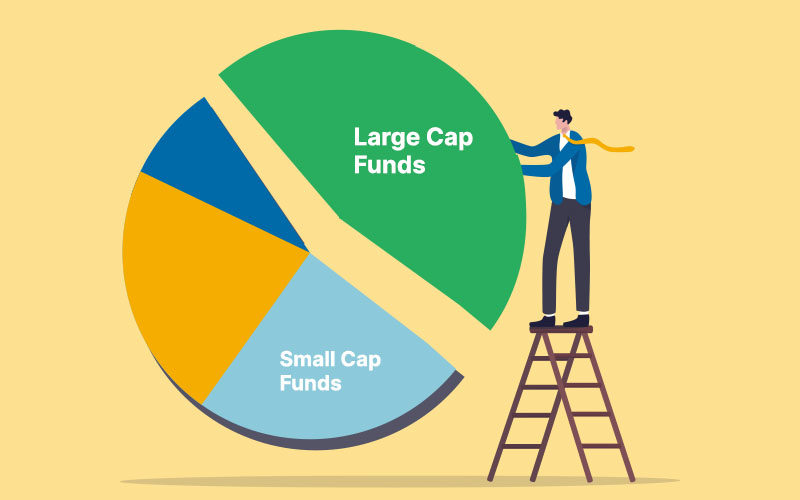As an investor, having a knowledge of the different types of stocks is crucial. Large-cap and small-cap stocks are the two types of stocks.
Also, understanding the difference between large-cap and small-cap stocks is crucial for making informed decisions. Large-cap stocks, also known as big-cap stocks, refer to companies with a market capitalization of over $10 billion, while small-cap stocks have a market capitalization between $300 million and $2 billion.
This post will educate you on these stock types and how to invest wisely.

What are Large-Cap Stocks
Large-cap stocks refer to shares of companies with a large market capitalization, typically valued at $10 billion or more. These companies are usually well-established, financially sound, and often leaders in their industries.
Think of household names like Apple, Microsoft, or Johnson & Johnson. They have a substantial market presence, and a robust track record, and are often seen as safe investments.
Advantages of Large-Cap Stocks
- Stability: These stocks are often known for their strength and ability to weather economic downturns better than smaller companies. It is very difficult for them to be out of the market in a short while because they build so much strength in the market.
- Dividends: Most large-cap companies pay regular dividends, providing a steady income stream to their investors – in addition to potential stock price appreciation.
- Lower Volatility: The sheer size and resources of these companies generally result in less price volatility, making them less risky.
Disadvantages of Large-Cap Stocks
- Slower Growth: Large-cap stocks often have slower growth rates compared to smaller companies due to the size of the company.
- Market Saturation: These companies are already dominant in their sectors, leaving less room for rapid expansion. This simply means they have already captured a large majority of the market share in a particular industry or sector, leaving limited opportunities for further growth or expansion
What are Small-Cap Stocks
These are companies with a market capitalization between $300 million and $2 billion. They are typically younger and have higher growth potential.
Examples: Emerging tech start-ups or innovative healthcare companies that are on the brink of significant breakthroughs.
Advantages of Small-Cap Stocks
- High Growth Potential: These stocks can offer substantial returns if the companies grow and succeed.
- Market Inefficiencies: They are often less analyzed because the company’s stock market price does not accurately reflect its true value or potential. This provides opportunities for savvy investors to find undervalued gems.
- Innovation: Smaller companies are usually more agile and can adapt quickly to market changes, driving innovation.
Disadvantages of Small-Cap Stocks
- Higher Risk: The potential for high rewards comes with higher risk. These companies are more susceptible to economic fluctuations and may have less access to capital.
- Volatility: Small-cap stocks can be much more volatile, leading to significant price swings.
Why Diversification Strategy is Important
Investing in both large-cap and small-cap stocks can bring balance to your portfolio by combining stability and growth potential. Also, diversification helps mitigate risks—when one part of your portfolio underperforms, another may excel, balancing the overall performance.
Example of portfolio allocation
A balanced portfolio might look something like this:
50% Large-Cap Stocks: For stability and steady growth.
30% Small-Cap Stocks: For higher growth potential.
20% Other Investments: Including bonds, international stocks, or real estate.
Why you Should Invest with Trove Finance
Trove Finance offers an accessible and user-friendly platform for managing your investments. Here’s how this platform can help you invest in large-cap and small-cap stocks effectively:
1. Ease of Use
The platform is designed with the user in mind, providing a seamless experience for both new and experienced investors. The interface is intuitive, making it easy to navigate and manage your portfolio.
2. Educational Resources
The investment platform offers a wealth of educational resources, from articles and investment courses at Trove University. These tools can help you understand the intricacies of large-cap and small-cap stocks, making informed decisions easier.
3. Diverse Investment Options
Trove Finance provides access to a wide range of stocks, including both large-cap and small-cap options. This variety allows you to build a diversified portfolio that aligns with your financial goals and risk tolerance.
4. Real-Time Data and Analytics
Having access to real-time market data and comprehensive analytics can make a significant difference in your investment strategy. Trove Finance offers these tools to help you stay informed and make timely decisions.

Read Also: Understanding Earnings Per Share (EPS): All You Need to Know
Conclusion
Investing in large-cap and small-cap stocks offers a balanced approach to building wealth and ensuring you don’t retire broke. Large-cap stocks provide stability and steady growth, while small-cap stocks offer the potential for significant returns.
By diversifying your portfolio and leveraging the tools and resources available through Trove Finance, you can make informed decisions that align with your financial objectives.



